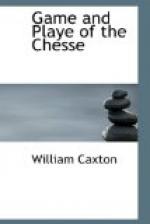“And emong alle other good werkys It is a werke of ryght special recomendacion to enforme and to late vnderstonde wysedom and vertue vnto them that be not lernyd ne can not dyscerne wysedom fro folye Th[=e]ne emonge whom there was an excellent doctour of dyuynyte in the royame of fraunce of the ordre of thospytal of Saynt Johns of Jherusalem which entended the same and hath made a book of the chesse moralysed whiche at suche tyme as I was resident in brudgys in the counte of Flaundres cam into my handes/ whiche whan I had redde and ouerseen/ me semed ful necessarye for to be had in englisshe/ And in eschewyng of ydlenes And to thende that s[=o]me which haue not seen it/ ne [=v]nderstonde frenssh ne latyn J delybered in my self to translate it in to our maternal tonge/ And whan I so had achyeued the sayd translacion/ J dyde doo sette in enprynte a certeyn nombre of theym/ Whiche anone were depesshed and solde wherfore by cause thys sayd book is ful of holsom wysedom and requysyte vnto euery astate and degree/ J haue purposed to enprynte it/ shewyng therin the figures of suche persons as longen to the playe.”
It is clear from this that both the translation and printing belong to the period of Caxton’s residence in Bruges. From the use of the instrumental form “dyde doo sette en enprynte” it might be thought that Caxton employed the services of some printer, but although commonly so employed, there are instances which will not bear this interpretation of its intention.[5] He either employed a printer or made some partnerfhip with one, and there are various indications that confirm Mr. Blades’ theory that the book came from the press of Colard Mansion.
The second edition is undoubtedly the work of our first English printer. “Explicit per Caxton” is the unambiguous statement of the colophon. It is a much more advanced specimen of typography than the first edition. It has signatures, of which a, b, c, d, e, f, g, h, i, are quaternions, k and l are terternions, making in all eighty-four leaves, of which the first is blank. There is no title-page, and the type used is that which Mr. Blades reckons as No. 2*. The lines are spaced out to an even length. There are twenty-nine lines to a full page, and the full line measures 4-7/8 inches. The prologue begins on a ij., and the table of chapters begins on the next page. The text begins on the recto of a iii.




